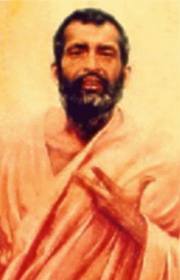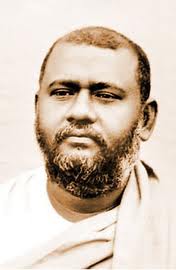(Continued from Part 1.)
Rakhal Ghosh, later Swami Brahmananda
A second example of an exit after rememberi9ng one’s past identity is Rakhal Ghosh or Swami Brahmananda. Sri Ramakrishna was married to Sarada Devi but they never had marital relations. The Divine Mother told Sri Ramakrishna in a vision that he was to have a spiritual son, an eternal companion, who was Rakhal. Prior to Rakhal’s arival, Sri Ramakrishna had a second confirming experience.
“A few moments before Rakhal actually arrived [Sri Ramakrishna had a] vision. Suddenly he saw a hundred-petaled lotus blooming on the bosom of the Ganges, each of its petals shining with exquisite loveliness. On the lotus two boys were dancing with anklets on their feet. One of them was Sri Krishna himself; the other was the same boy he had seen in his earlier vision. Their dance was indescribably beautiful; every movement they made seemed to splash foam, as it were, from an ocean of sweetness. Sri Ramakrishna was lost in ecstacy.
“Just then a boat arrived carrying Manomohan and Rakhal. Sri Ramakrishna looked at Rakhal in bewilderment. ‘What is this?’ he thought to himself; ‘Here is the boy I saw standing under the banyan tree; here is the boy Mother placed on my lap; here is the boy I saw just now dancing on the lotus with Sri. Krishna. This is the pure-hearted companion I prayed for to Mother.’” (23)
As with Naren, so with Rakhal: Sri Ramakrishna explained that if he was to remember his former identity as Krishna’
s boyhood companion, he too would leave his body.
“Since Mother revealed to me that Rakhal is the playmate of Sri Krishna and one of the shepherd boys of Brindaban [sic], I was afraid lest he should be reminded of his past incarnation. If he remembered his association with Sri Krishna while at Brindaban, he might give up his body there.” (24)
Swami Brahmananda’s disciple, Swami Prabhananda, explained how all of the latter’s disciples knew not to divulge the secret.
“I have already described how Sri Ramakrishna saw Rakhal dancing with Sri Krishna on a mystic lotus shortly before the boy’s first visit to Dakshineswar. Only a few intimate disciples knew of this vision, and Sri Ramakrishna had warned them never to reveal it to Maharaj, explaining that if he realized his true nature as the Eternal Companion of Krishna, he would leave his mortal body. The secret had been very carefully guarded.” (25)
Under the master’s watchful eye, Rakhal was initiated into spiritual life with a vision of his Chosen Ideal, Sri Krishna:
“‘Look,’ said the Master [Ramakrishna], ‘there is your Chosen Ideal!’ Rakhal in ecstatic vision saw his chosen aspect of the Godhead standing before him — living and luminous, with a smile playing on his lips. When Rakhal regained his external consciousness and saw Sri Ramakrishna, he prostrated at his feet with loving devotion. He had known and experienced the divine power and grace of his guru.” (26)
As Swami Brahmananda, Rakhal was graced with high visions of God:
“[Swami] Turiyananda has told us that whenever Maharaj entered any shrine he would be filled with ecstatic devotion for that particular aspect of God to which the temple was dedicated, and that, ultimately he would have direct vision of the living deity within that temple. In later years, when Maharaj was asked by a disciple if the gods and goddesses are real, he answered: ‘The one Godhead has many spiritual forms. All these forms are real. A seer can see them and talk to them.'” (27)
Finally at Omkarnath Templel, Swami Brahmananda attained the coveted experience of nirvikalpa samadhi. (He later attained higher states.)
“Here, amidst charming natural surroundings, [Swami Brahmananda] lived continuously in nirvikalpa samadhi for six days and six nights, completely unconscious of the outside world. When at last he came back to normal consciousness, his face shone with a heavenly joy. He had experienced God in the impersonal, absolute aspect, and had realized the identity of Atman with Brahman.” (28)
After a long life of service as head of the Ramakrishna Order, Swami Brahmananda finally remembered his former identity as Krishna’s playmate, and when he did he left the Earth.
“Ramlal Dad was singing: ‘Come back, O Krishna, come back to Brindaban….’ At that moment Maharaj seemed transported to a realm beyond this earth. The joking and laughter stopped. The atmosphere became calm and serene. It may be at this moment Maharaj got a partial glimpse of his true nature and knew himself to God’s Eternal Companion. The events that followed seem to point to some such revelation.” (29)
His last vision prior to his death was of himself dancing on the lotus leaves with Krishna. Here is a description of his final moments and passing.
“Maharaj was silent for a while. … Suddenly out of the silence, the voice of Maharaj was heard: ‘Ah, that inexpressible light! Ramakrishna, the Krishna of my Ramakrishna. … I am the shepherd boy. Put anklets on my feet. I want to dance with my Krishna. I want to hold his hand – the little boy Krishna…. Ah, Krishna, my Krishna, you have come! Krishna…. Krishna…. Can’t you see him? Haven’t you eyes to see? Oh, how beautiful! My Krishna…. on the lotus…. eternal…. the Sweet one!
“’My play is over now. Look! The child Krishna is caressing me. He is calling me to come away with him! I am coming….’
“The tenderness and heavenly compassion that filled his heart were expressed in every word he uttered. … Everyone knew that the fateful was approaching, and that Maharaj was taking his final leave. … He maintained perfect consciousness right up to the last moment of his life.
“As the last evening faded into night, his chest suddenly heaved. It was as if a last great wave of breath passed up the body to the throat. His half-closed eyes opened, and he gazed into the distance, his eyes shining with a brilliance and unspeakable beauty.
“Thus it was that on April 10, 1922, the life left his body.” (30)
These then are examples of spiritual masters leaving the Earth plane when they remembered their true o0r past identities. Undoubtedly their experiences are sublime and well past anything we might hope for, but they do illustrate nonetheless how even masters of elevated accomplishment can be drawn from the body when remembrance of their earlier lives comes to them.
Footnotes
(1) Paramahansa Ramakrishna (hereafter PR) in Nikhilananda, Swami, trans. The Gospel of Sri Ramakrishna. New York: Ramakrishna-Vivekananda Center, 1978; c1942, 72. (Hereafter GSR.)
(2) PR in GSR, 279.
(3) Ibid., 750.
(4) Ibid., 933.
(5) Ibid., 943.
(6) PR in Swami Chetanananda, ed. and trans. Ramakrishna as We Saw Him. St Louis: Vedanta Society of St. Louis, 1990, 55-6.
(7) Swami Shivananda of people like Nistarini Ghosh in Swami Chetanananda. They Lived with God. St. Louis. Vedanta Society of St. Louis, 1989, 249.
(8) PR in GSR, 206-7.
(9) Ibid., 237.
(10) Swami Brahmananda in Swami Prabhavananda, The Eternal Companion. Brahmananda. Hollywood: Vedanta Press, 1970; cl944. , 189. (Hereafter EC.)
(11) Swami Nikhilananda, trans. Vivekananda: The Yogas and Other Works. New York: Ramakrishna-Vivekananda Center, 1953. , 14. (Hereafter VIV.)
(12) PR in GSR, 279.
(13) Ibid., 91-2.)
(14) Ibid., 810.)
(15) Ibid., 811.
(16) PR to Narendra, in ibid., 57.
(17) Swami Nikhilananda in ibid., 70.
(18) PR in GSR, 71-2.
(19) Ibid., 72.
(20) Swami Nikhilananda in ibid., 72.
(21) VIV, 176.
(22) Ibid., 178.
(23) EC, 15.
(24) PR in ibid., 29.
(25) Swami Prabhavavanda in ibid., 100.
(26) Ibid., 25-6.
(27) Ibid., 44.
(28) Ib.d, 37.)
(29) Ibid., 101.
(30) Ibid., 104-6.



